Kestrel Eye Block-II Microsatellite
EO
Mission complete
Kestrel Eye Block-II Microsatellite (KE-IIM) was a pathfinder mission for a constellation of low-cost satellites that can support ultra-quick tasking to deliver responsive imagery to the warfighter on the ground. The satellite was launched in August 2017 and retired in August 2018, and was operated by the U.S. Army Space and Missile Command.
Quick facts
Overview
| Mission type | EO |
| Mission status | Mission complete |

Summary
Mission Capabilities
Kestrel Eye-2M featured the optical imaging Harris Telescope, which included a high grade industrial COTS (Commercial-Off-The-Shelf) camera. The telescope interface and unit allowed for different COTS cameras to be used, providing an easy upward growth of the satellite. The satellite provided low-cost imagery in support of time-sensitive operations, such as monitoring extreme weather and natural disasters. Imaging data from Kestrel Eye could be downlinked directly to provide rapid situational awareness to Army brigade combat teams in warzones.
Perfomance Specifications
Kestrel Eye-2M’s Harris telescope provided electro-optical imagery at a spatial resolution of 1.5 m. The satellite had the objective of providing near-real time imagery with rapid tasking for the delivery of a request.
The satellite was deployed into a low-Earth near-circular orbit with an altitude of approximately 400 km, and an inclination of 51.6°.
Space and Hardware Components
The Kestrel Eye-2M satellite was based on MAI’s (Maryland Aerospace Inc.’s) MAGICBus platform, a low-cost microsatellite bus with built-in communications encryption, orbit maintenance control, attitude control and fast pointing. The satellite had a mass of approximately 50 kg and communicates in S-band frequency with capability for continuous communications with the ground.
The use of low-cost satellites enables a constellation of many satellites to be established to obtain rapid revisit cycle imagery. Kestrel Eye 2M operated for ten months, exceeding its six month design life.
KE-IIM (Kestrel Eye Block-II Microsatellite)
Spacecraft Launch Mission Status Ground System References
Kestrel Eye, also referred to as Kestrel Eye-2M, was a small imaging technology demonstration spacecraft project of the U.S. Army SMDC (Space and Missile Defense Command)/U.S. Army Forces Strategic Command (SMDC/ARSTRAT) Technical Center (TC) in Huntsville, AL. The current KE program began as a KE Block I proof-of-concept or pathfinder. Derived from the KE Block I design, a KE Block II concept improvement was developed. In 2012, the Army, in conjunction with the OSD/JCTD (Office of the Secretary of Defense/Joint Capability Technology Demonstration) program, initiated the Kestrel Eye Block II as an electrooptical microsatellite-class imagery satellite to support the tactical warfighter. 1)
Two contractors were selected to build second-generation KE satellites, designated KE Block-IIA (Spaceflight Industries) and KE Block-IIM (Maryland Aerospace Incorporated). As a JCTD, the KE program is teamed with OSD, the Combatant Command (COCOM) sponsor - U.S. Pacific Command (USPACOM), and transition agent - the Army Program Executive Office (PEO) Missiles and Space.
The primary objective of the KE-II demonstration was to task the satellite to take an image, which was assessed by an independent evaluator for its military value. KE demonstrated the critical technologies required by an operational system, by experimentally verifiying a concept of operations (CONOPS) and military utility, followed by an acquisition transition.
The intent of KE-II was to demonstrate a tactical space-based imagery microsatellite. A KE-II satellite constellation would provide dramatically lower unit cost than typical space based assets. With this low unit cost, large numbers of satellites can be procured enabling the system to be dedicated to the tactical warfighters.
Key advantages of Kestrel Eye-II include:
• Smaller size and greater number: affordable, persistent presence, lower probability of detection, less vulnerable to anti-satellite weapons
• Graceful degradation: no single shot, launch failure or anomaly causes complete loss of service.
Background: Game-changing technology starts with a visionary idea. In 2005, Steve Fujikawa and Dr. George Sebestyen of Maryland Aerospace, Inc. (MAI, now Adcole Maryland Aerospace (AMA)) conceived of an imaging microsatellite and took their idea to DARPA (Defense Advanced Research Projects Agency) Tactical Technology Office (TTO). DARPA recognized the value of the concept and provided MAI with funding to develop key technologies. Fujikawa named the fledgling program Kestrel Eye in reference to the keen vision of a small, agile bird of prey. DARPA later transitioned the successful Kestrel Eye study to USASMDC/ARSTRAT in 2007, where the study was transitioned into the Kestrel Eye Block I program in 2008.
Before Block I was completed, the Block II program was initiated as a JCTD (Joint Capability Technology Demo) in 2013. The Block II program significantly enhanced Block I by adding a star tracker for more accurate pointing, larger reaction wheels for more rapid slewing, and a propulsion system to control the relative phasing of a future constellation of Kestrel Eye ISR (Intelligence, Surveillance, and Reconnaissance) satellites.
Operations Concept: Kestrel Eye was specifically conceived to simplify the process for collecting tactical imagery in a way that would significantly shorten the cycle time between the request for an image and delivery of the requested image back to the requesting warfighter - illustrated in a simplified manner by the following three major process steps:
1) Battlefield commanders identify an area they wish to image using map coordinates such as latitude and longitude. The warfighter's request for imagery is relayed to a local command center that is connected by existing tactical communications networks. The request is prioritized and merged with other imagery requests from other units in the same theater and is then uplinked to the Kestrel Eye spacecraft as it rises over the battle area.
2) The Kestrel Eye satellite receives requests for multiple images and begins a sequence of maneuvers to capture as many requested images as possible in an optimized set of attitude slews. As the line of sight settles on each targeted coordinate, an image is snapped before beginning a slew to the next target.
3) The image is compressed and metadata is attached using NITF (National Imagery Transmission Format) standards. During the same communications pass, the captured image is rapidly transmitted to the ground and then communicated via tactical networks back to the requesting warfighter. The entire process can take place rapidly.
Spacecraft
The KE Block-II microsatellite, was developed by AMA (Adcole Maryland Aerospace) LLC of Crofton, MD, (former MAI (Maryland Aerospace Inc.)) for operation by the U.S. Army Space and Missile Defense Command as a pathfinder for a constellation of low-cost satellites that can support ultra-quick tasking to deliver responsive imagery to the warfighter on the ground. 2)
Kestrel Eye was developed as a microsatellite-class (50 kg) imaging satellite that can be tasked directly by the tactical ground component warfighter and delivers user-ready imagery products directly to the warfighter via a data network that is also accessible by other warfighters without any relay via the U.S. main land and no data filtering. The primary objective was to demonstrate a tactical space-based imagery microsatellite that could be produced in series to provide a persistent capability to deployed forces.
The initial Kestrel Eye mission demonstrated the satellite can be tasked to take a picture of a target ground area of interest and return that image to the warfighter during the same satellite pass with a tasking-to-product cycle of ten minutes or less. Up to 40 Kestrel Eye satellites are considered to be launched and concepts also exist for a responsive launch scheme to be able to set up passes over regions of interest as required. 3)
The Kestrel Eye program will extend the UAV (Unmanned Aerial Vehicle) paradigm and provide coverage over denied areas, invulnerable to surface-to-air missiles. The use of low-cost satellites enables a constellation of many satellites to be established to collect rapid revisit cycle imagery – covering relevant areas much more often than the current powerful & expensive space assets. Kestrel Eye's operational concept comprises the satellites in orbit and laptops & S-band transceivers on the ground to request, receive and display imagery collected by the satellite.
Plans for Kestrel Eye foresee a constellation with five orbital planes and eight satellites per plane with a unit cost of around $1.3 million and the use of small-satellite launch vehicles to be able to deliver the satellites to their correct positions within the constellation at the required schedule – not possible when taking a shared ride on a larger launch vehicle.
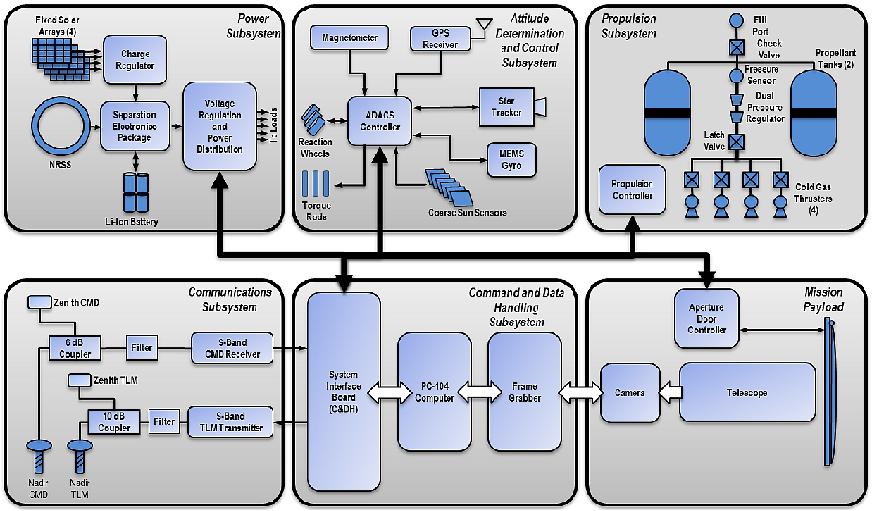
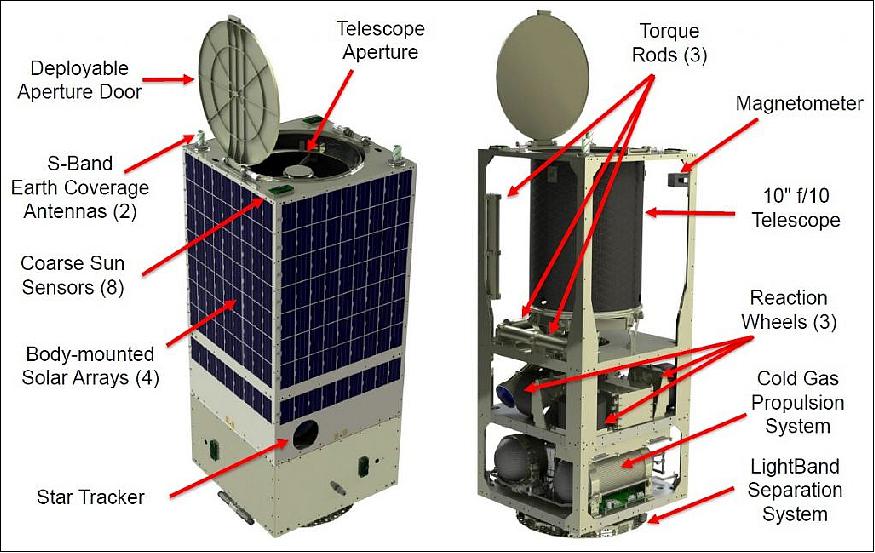
Operators on the ground would have a simple user interface displaying a map with the satellite's ground track and field of regard that allows users to select targets along the satellite's ground track and directly send the request to the satellite. A novel software on the satellite would then compute the planned imaging sequence, taking into account multiple requests made for a single pass, and actuate the satellite's pointing systems and imaging payload to capture 1.5 m resolution imagery of the targets. The operation of the satellite is fully autonomous and designed to maximize the number of targets imaged during a single pass.
The Kestrel Eye-2M satellites are based on MAI's MAGICBus platform – a low-cost microsatellite bus with built-in communications encryption, propulsive orbit maintenance capability for constellation control, accurate attitude control and fast pointing combined in a compact satellite platform that enables launch as secondary payload on large launchers or dedicated rides on small satellite launchers. In its electro-optical imaging configuration, the satellite platform is purpose-built to be able to deliver imagery in near-real time, featuring a 25 cm aperture telescope.
The MAGICBus can provide total mass budgets between 50 and 102 kg with sizes between 38 x 38 x 97 cm and 46 x 46 x 107 cm. The satellite uses Star Trackers as primary attitude sensors with coarse sun sensors, magnetometers and an inertial platform in an assisting role while three reaction wheels and magnetic torquers provide attitude actuation. The platform achieves a pointing knowledge of 0.01º and a pointing accuracy of ±0.15º, capable of supporting slew rates of 3º/s and off-nadir imaging at up to 30º.
EPS (Electrical Power Subsystem): The Block II EPS uses four body-mounted solar arrays to generate power. This approach simplifies the spacecraft ConOps and configuration by generating power in virtually any attitude without the need to deploy solar arrays. The Separation Electronics Package (SEP) ensures that the spacecraft is not powered until separated from the Launch Vehicle. The SEP also contains circuitry that aids in safely powering down and recovering the system in the event of low states of battery charge. Upon separation, the arrays are connected to the charge regulator and battery charge electronics to charge the Lithium Ion (Li-Ion) battery. Borrowing from CubeSat and NanoSat roots, the Block II Li-Ion battery is comprised of sixteen battery cells typically used in laptop computers. These cells have been very carefully tested, screened, selected, and packaged to meet applicable safety standards and enhance the robustness and reliability of the Block II battery. Voltage regulation and power distribution electronics provide switched and regulated power to other subsystems as commanded.
Communications Subsystem: The Block II spacecraft uses two quadrifilar helix antennas on the (typically) nadir-facing end of the spacecraft and two patch antennas on the (typically) zenith-facing end. These four antennas – one receive and one transmit antenna each on the nadir and zenith ends – are connected to the command receiver and telemetry transmitter respectively using directional couplers. This arrangement allows for continuous communications to the ground at any attitude with improved link margins in attitudes where the quadrifilar helix antennas are facing the ground. The Quasonix S-band command receiver and telemetry transmitter are COTS products originally built for aircraft use but readily adapted for spacecraft applications. These units signal to the ground using OQPSK (Offset Quadrature Phase Shift Keying) modulation at data rates of > 1 Mbit/s on the downlink using a variable power transmitter. Communications are software-encrypted and sent to the ground via >10 W S-band Earth Coverage Antennas.
C&DH (Command and Data Handling Subsystem): The Block II C&DH Subsystem consists of three 10 cm square CubeSat form-factor boards including the AMA System Interface Board (SIB), a COTS PC-104 Image Processor, and the COTS Active Silicon Phoenix Frame Grabber. The SIB provides all of the in-flight interfaces to the ground for command reception and telemetry transmission as well as all software and hardware interfaces for command processing. The Frame Grabber provides the direct interface to the camera to capture and store images for transmission to the imager, for processing. The imager is used for computationally intensive activities such as image processing and NITF formatting prior to transmission to the ground system.
ADACS (Attitude Determination And Control Subsystem): The Block II ADACS employs multiple flight-proven components to ensure reliable pointing of the Block II spacecraft. Attitude knowledge is chiefly derived from a single flight-heritage Star Tracker. The ADACS also uses a MEMS gyro and eight Coarse Sun Sensors mounted on the six cardinal sides of the spacecraft as well as a magnetometer for momentum management. Attitude control is realized using three orthogonally mounted flight-heritage reaction wheels as well as three magnetic torque rods for momentum management. The ADACS electronics are an AMA-designed module derived from both the Block I ADACS computer and AMA's existing product line of CubeSat ADACS components. The ADACS also uses a COTS GPS receiver to enable on-board orbit determination.
Propulsion Subsystem: One of the key differences between Kestrel Eye Block I and Block II is the addition of a propulsion subsystem. This subsystem is primarily intended to allow multiple Block II spacecraft to be employed in a constellation. A constellation consisting of multiple planes of evenly spaced Kestrel Eye vehicles would provide for nearly continuous availability of tactical imaging, i.e., one spacecraft would be rising shortly before or after another spacecraft is setting over a particular area. Proper dispersion and phasing of spacecraft requires a modest delta-V capability aboard each spacecraft. Block II therefore employs a simple cold-gas propulsion subsystem to provide this delta-V. The Block II propulsion subsystem uses two composite-overwrapped pressure vessels to store up to nitrogen gas. The subsystem includes a pressure sensor to provide telemetry of the remaining delta-V, dual pressure regulators, a magnetic latch valve, and four flight-proven cold gas thrusters located on the four corners of the Propulsion Deck surrounding the NRSS (NanoRacks Separation System ). The four thrusters are canted outwards to provide 3 axis torques. The actuation of each thruster is duty-cycle controlled by the propulsion controller in a closed-loop system that actuates rate to control spacecraft attitude during delta-V maneuvers. The spacecraft must cease imaging operations and change attitude to align the long axis of the spacecraft in the desired delta-V direction before beginning a propulsive maneuver; after the maneuver, the spacecraft returns to its nominal attitude to resume imaging operations.
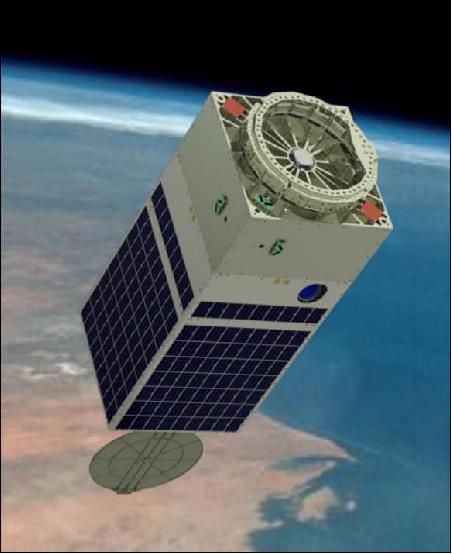
Launch
The Kestrel Eye-IIM was launched as a secondary payload on August 14, 2017 (16:31.37 UTC) from Launch Complex 39A (LC-39A) at NASA's Kennedy Space Center, Florida. The primary mission was the SpaceX CRS-12 Dragon logistics flight on a Falcon-9 v1.2 vehicle to the ISS. 4) 5) 6)
SpaceX's twelfth contracted cargo resupply mission with NASA to the International Space Station deliver ed more than 2,910 kg of science and research, crew supplies and vehicle hardware to the orbital laboratory and its crew. This included 1,652 kg of pressurized cargo with packaging bound for the ISS, and 1,258 kg of unpressurized cargo composed of the CREAM (Cosmic-Ray Energetics and Mass) instrument, to be mounted externally to the ISS (mounting on a facility outside the station's Japanese Kibo module). The CREAM payload, also referred to as ISS-CREAM) will spend at least three years sampling particles sent speeding through the universe by cataclysmic supernova explosions, and perhaps other exotic phenomena like dark matter. 7)
Orbit: Near circular orbit, altitude of ~400 km, inclination = 51.6º.
Secondary Payloads
Four small satellites inside the Dragon capsule will be transferred inside the space station for deployment later this year.
• Kestrel Eye-2M is a pathfinder microsatellite (~50 kg) for a potential constellation of Earth-imaging spacecraft for the U.S. military. From the ISS orbit, Kestrel Eye-2M's optical camera will be able to spot objects on Earth's surface about the size of a car. The objective Kestrel Eye imaging data is to downlink directly to provide rapid situational awareness to Army brigade combat teams in theater without the need for continental United States relays.
After launch, the KE-2M satellite will spend a period of time on the ISS awaiting JEM (Japanese Experiment Module) airlock scheduling before deployment. During the first two months on-orbit, the satellite checkout operations will be conducted, culminating in a technical demonstration.
Operational Requirements and Protocols: The NanoRacks-KE- IIM mission requirements include crew resources for on-orbit assembly and pre-deployment logistics. Deployment is to occur as soon as possible after ISS reboost to maximize orbital lifetime. Video and photogrammetry services are required to characterize NanoRacks Kaber deployment kinematics and provide payload developer mission assurance feedback and ephemeris data at the time of deployment. ISS crew assembly procedures have been prepared to guide the crew through proper and safe assembly of the NanoRacks-KE- IIM. JEM airlock and MSS SPDM operations are governed by the standard operations in place for those resources. Following deployment by the NanoRacks Kaber deployer, the NanoRacks-KE- IIM begins nominal mission operations limited by its orbital lifetime expected to be approximately six months. 8)
• ASTERIA (Arcsecond Space Telescope Enabling Research in Astrophysics), a 6U CubeSat (12 kg) of MIT and NASA/JPL. The objective is to test miniature telescope components that could be used in future small satellites to observe stars and search for exoplanets.
• Dellingr, a NASA demonstration mission on a 6U CubeSat.
• OSIRIS (Orbital Satellite for Investigating the Response of the Ionosphere to Stimulation and Space Weather) is a 3U Cubesat of PSU (Penn State University), University Park, PA, USA. Working in coordination with the Arecibo Observatory, a giant radar antenna in Puerto Rico, OSIRIS-3U will fly into a region of the ionosphere heated to simulate the conditions caused by solar storms.
Mission Status
• August 2018: The Kestrel Eye II mission concludes. The microsatellite operated for over ten months, exceeding its six month design life. The mission achieved its objectives, providing foundation for further developments of small imaging satellites and rapid imagery tasking. 14)
• June 2018: The Kestrel Eye II microsatellite has a mass of ~50 kg and provides electro-optical images with tactically useful resolution as requested by the warfighters in theater. The warfighters in theater will task and receive data from the satellite during the same pass overhead. The data can be downlinked directly to provide rapid situational awareness to our Army Brigade Combat Teams in theater without the need for continental United States relays. By using a small satellite, the required logistics footprint in the field is reduced as compared to an UAS (Unmanned Aerial System).
- In addition, developing a constellation of small satellites increases survivability and provides graceful degradation as no individual satellite is critical to the functioning of the constellation. Once Kestrel Eye reaches production, it will have a relatively low cost at approximately $2 million per spacecraft and will have an operational life of greater than one year in low earth orbit. With its low cost, large numbers of satellites can be procured enabling the system to be dedicated to the tactical warfighter. Kestrel Eye was successfully deployed from the International Space Station on 24 October 2017. The performance of this satellite is now undergoing investigation to validate the specifications of the satellite are met. The checkout investigation is being performed jointly by a ground station in Huntsville, AL operated by USASMDC/ARSTRAT and one in Hawaii operated by United States Pacific Command (USPACOM). At the conclusion of those investigations, the satellite will undergo a series of exercise experiments to evaluate if similar satellites could support critical operations. If the experiments are successful, it is expected satellites of similar capability can be procured/operated at a low cost (Ref. 2).
- In summary, Kestrel Eye has come a long way in the years since it was originated in 2005. The Block I vehicle - and now the Block II vehicle - has been designed and built. Kestrel Eye Block II was launched and the capability that Dr. George Sebestyen and Steve Fujikawa imagined when they conceived of Kestrel Eye has been realized. A target will be tasked for imaging and the requested image will be rapidly returned. That moment will put the warfighter on the threshold of a capability that battlefield commanders have sought since the dawn of spaceborne ISR more than fifty years ago.
• January 30, 2018: Adcole Maryland Aerospace, LLC and Quantum Research International, Inc. announced today that the Kestrel Eye Block IIM microsatellite is in orbit and functioning well following successful deployment from the International Space Station on 24 October 2017. The Kestrel Eye imaging satellite is the first on-orbit demonstration of an envisioned DoD (Department of Defense) constellation that may someday provide enhanced situational awareness to users on the ground through direct communications with tactical satellites under theater control.9)
- The successful deployment and operation of Kestrel Eye is a major milestone for these two companies, as well as the U.S. Army Space and Missile Defense Command / Army Forces Strategic Command (SMDC/ARSTRAT), the DoD Space Test Program who sponsored the satellite launch and deployment, and the evolving DoD space enterprise. This class of small, inexpensive, and yet highly capable satellites are expected to make space less expensive and more accessible, while simultaneously enhancing the resiliency and flexibility of future space architectures.
- The mission operations team was able to communicate with Kestrel Eye on the first available pass less than four hours after deployment of the satellite on 24 October, 2017. When the team established contact with the vehicle, they found it in excellent condition with a nearly fully-charged battery, controlled attitude rates, and healthy communications' links. Over the next few passes, the team was able to command the spacecraft into the planned pointing mode and has begun working through on-orbit test and commissioning plans.
• October 25, 2017: Now that KE2M is deployed a safe distance from ISS, the satellite will power up automatically and be ready to receive signals from the ground station, then transition into the first of four major phases. 10)
- The first phase is a technical checkout to verify satellite functionality and make any necessary adjustments. The second phase is a technical demonstration of the satellite to demonstrate full capability.
- The third phase is the operational demonstration conducted by the Kestrel Eye Joint Capability Technology Demonstration Combatant Command partner, U.S. Pacific Command. In the operational demonstration, a limited military utility assessment will be conducted by the independent assessor, Space and Naval Warfare Systems Command. — The fourth is residual operations where Kestrel Eye IIM will participate in a series of Army exercises.
• October 24, 2017: Early this morning, NanoRacks successfully deployed the Kestrel Eye IIM (KE2M) microsatellite via the Company's Kaber Microsatellite Deployer (Kaber) from the International Space Station. This is the largest satellite that NanoRacks has deployed to date, and the first deployed from the Kaber deployer. 11)
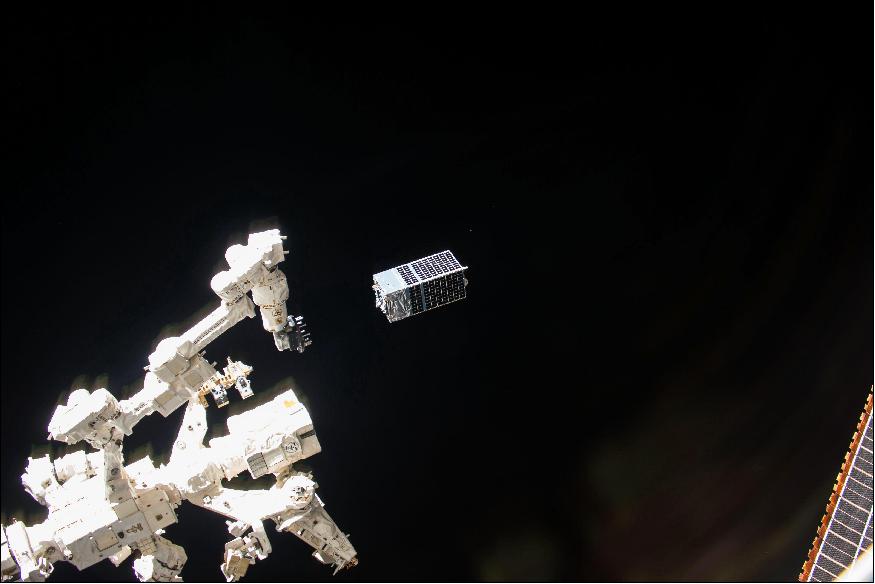
- "Customer demand pushed for larger satellite deployment in low-Earth orbit, so NanoRacks was there to accommodate," says NanoRacks CEO Jeffrey Manber. "We're thrilled to bring yet another commercial opportunity to the International Space Station, increasing utilization and bringing a new group of customers into our Space Station services."
- NanoRacks Kaber Deployment Program allows for a larger EXPRESS class of satellites to be deployed from the International Space Station, up to 100 kg. NanoRacks deploys these Kaber-class satellites currently through the Japanese Experiment Module Airlock, and will shift deployments to the NanoRacks Airlock Module when the Company's commercial Airlock becomes operational (planned for 2019).
- KE2M is an Army Space and Missile Defense Command (SMDC) and Adcole-Maryland Aerospace program, serving as a technology demonstration microsatellite carrying an optical imaging system payload, including a COTS (Commercial-Off-The-Shelf) telescope. The goal of KE2M's investigation is to demonstrate that small satellites are viable platforms for providing critical path support to operations and hosting advanced payloads.
• Aug. 16, 2017: Two days after departing from a launch pad on Florida's Space Coast, the SpaceX Dragon cargo capsule arrived at the International Space Station on August 16 with more than 2,910 kg of experiments and supplies after concluding an automated laser-guided approach. 13)
- Astronaut Jack Fischer aboard the space station used the lab's Canadian-built robotic arm (Canadarm2) to snare the robotic cargo craft at 10:52 GMT on Aug. 16 as they sailed about 400 km over the Pacific Ocean north of New Zealand.
- Around two hours later, ground controllers finished the installation of Dragon on the station's Harmony module, commanding 16 bolts to close and create a firm seal between the two vehicles.
- The station crew opened hatches between the Harmony module and Dragon's pressurized compartment later, a day earlier than planned.
- Flying under contract to NASA, the SpaceX supply ship ferried mostly research hardware, but also carried computer equipment, clothing, fresh food, ice cream and other treats for the crew.
- The cargo mission marked SpaceX's 11th successful operational supply delivery in 12 tries. - NASA inked a $1.6 billion contract with SpaceX in 2008 for 12 logistics flights to the station. This mission wraps up work under the original resupply contract, but NASA extended the agreement for eight additional cargo launches through 2019. SpaceX also has a separate, follow-on contract with NASA for at least flights of upgraded Dragon cargo capsules to the station from 2019 through 2024.
- The station's six-person crew will unload the payloads inside, overseeing a multitude of biological experiments before the ship's departure and return to Earth next month.
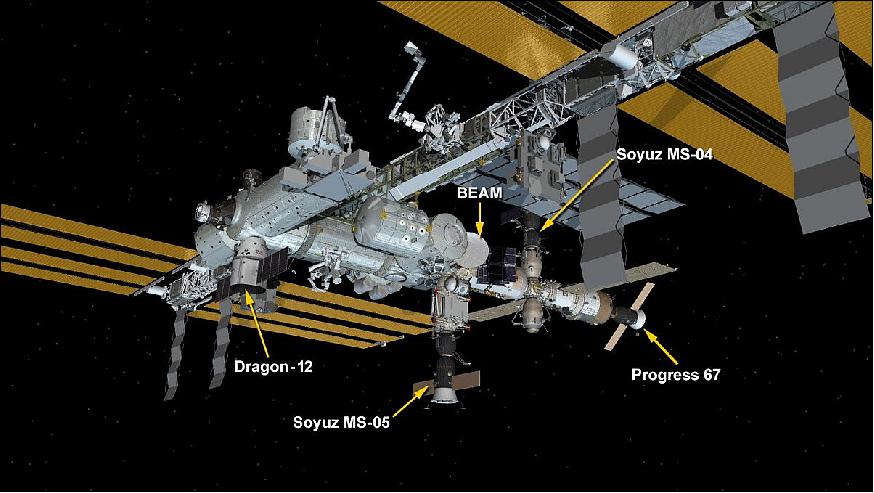
Sensor Completment
The KE-IIM spacecraft is designed and built to be a tactical ISR (Intelligence, Surveillance, and Reconnaissance) satellite. As such, it is driven by and built around the characteristics of its mission payload. The core of the mission payload is a Harris Corporation 10-inch (25 cm) telescope, shown in Figure 6. This lightweight, compact, space-qualified telescope mounts to the spacecraft at three aft hard-points and provides an optical interface that easily couples to a COTS (Commercial-Off-The-Shelf) camera. This flexible interface allows the cameras become available with either improved sensitivity or changes in imaging wavebands.
The Harris Telescope mates to a high grade industrial COTS camera. The camera is an advanced, rugged and extremely programmable camera series focused on the military and aerospace market. The camera features a thermally optimized design, low noise, and large dynamic range. The camera uses industrial components assuring dependable use across both a wide temperature range and a wide vibration spectrum. The flexibility and interface of this unit provides for an easy upward growth path for Kestrel Eye. The combination of the Harris 25 cm telescope and the camera yields 1.5m GSD (Ground Sample Distance) image, covering a ground area of 3 km x 5 km from a 400 km orbit. Strip-imaging of larger areas is also possible. Onboard storage is provided for up to 600 images.
Notably, KE2M could provide lower-cost Earth imagery in support of time-sensitive operations, such as tracking severe weather and detecting natural disasters.
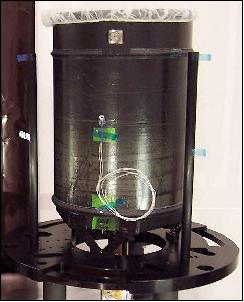
Each image from the camera is captured using a COTS frame grabber and is then compressed onboard and formatted using NITF (National Imagery Transmission Format) standards for transmission to the ground. The use of the NITF format for images allows these images to be easily transmitted, stored, retrieved, analyzed, ingested, manipulated, and exploited with readily available, widely promulgated tools used in the DoD and Intelligence Community.
Ground Segment
The responsiveness of the Kestrel Eye Satellite System is ultimately dependent upon the transportability and ease of use of the ground system. Modern military forces need to be on the move; any ground system that is not compliant with this need would negate the value of the entire Kestrel Eye concept (Ref. 2). The ground system for Kestrel Eye is designed and built to be readily transportable, easily deployed, rapidly set up, and adaptable to warfighter operations in the field. The ground system for Kestrel Eye is comprised of two major elements, which are the GATR Technologies TRAC, a portable 2.4 m satellite tracking imaging ground station and the KEGS (Kestrel Eye Ground System).
The original ground station for KE was developed to support the singular KE Block I satellite and was intended to be used in a laboratory setting. A targeting utility was demonstrated early in the KE Block I program with hardware-in-the-loop and the KEDS (Kestrel Eye Dynamic Simulator), which allowed the satellite imaging capability to be demonstrated, promulgating the vision for KE. Refinement of architecture requirements and feedback from representative user forums in 2013 and 2014 helped shape the ground station requirements and use cases. The main requirements for the ground station were to enable the user to easily choose a target of interest (point-and-click) and receive the satellite image during the same satellite access time (pass). In the summer of 2014, the KE team began work on developing the KEGS, incorporating the design upgrades, architecture differences and user feedback.
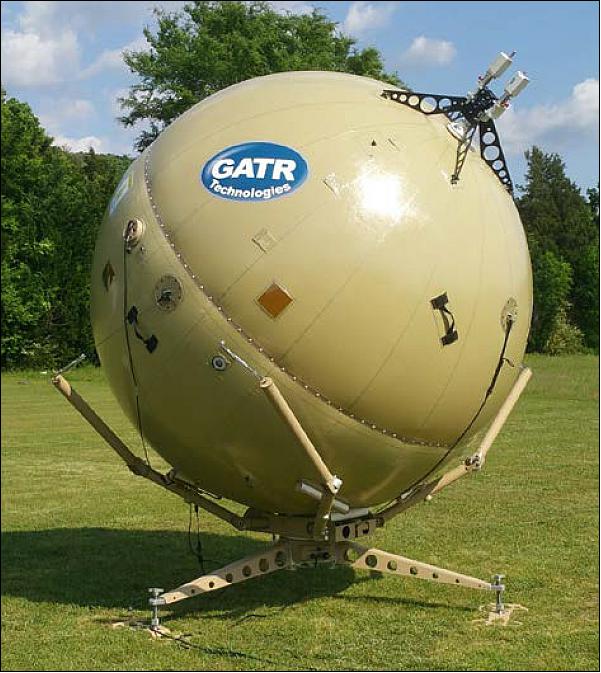
GATR Ground Station Antenna: GATR inflatable satellite antennas are characterized by GATR Technologies (a division of CUBIC Corporation, San Diego) as "the most portable satellite antennas in the world". Compared to other deployable rigid dishes of comparable size, GATR's unique design enables extreme portability, reduced cost of ownership, reliability in extreme environments, and ease of set up. The GATR 2.4 meter antenna is GATR's flagship product; a single-band GATR 2.4 meter antenna system can be packed into two cases weighing less than 45 kg each. For Kestrel Eye, GATR Technologies has adapted their GATR 2.4 m antenna to create the GATR-TRAC antenna, shown in Figure 7. This LEO (Low Earth Orbit) tracking version can be packed into four airline checkable cases. GATR-TRAC is an innovative twist on a unique product and a major step forward in transportable satellite ground station technology. The antenna reflector surface is a stretched membrane inside of the spherical outer shell of the inflatable structure. A differential pressure between one side of this interior membrane and the other, combined with the size, shape, and reinforcing members of the membrane, create the very exacting surface tolerances needed for a reflective antenna surface capable of operations at frequencies up to Ka-band. For GATR-TRAC, the entire spherical antenna structure is placed on rollers set atop a rotating platform. The motion of the sphere on these rollers creates elevation mobility and the rotation of the platform creates azimuth pointing. GATR-TRAC uses a computer that ingests satellite ephemerides to calculate open-loop program-track antenna vectors based on latitude, longitude, and azimuthal orientation. The antenna feed is mounted on the outer surface of the sphere. The GATR-TRAC is then connected to KEGS.
KEGS (Kestrel Eye Ground System): KEGS is a transportable rack of equipment shown in Figure 8 containing a Quasonix receiver, transmitter, gigabit switch, data processing unit, and a GPS receiver for time and location services. A ruggedized laptop computer is included to provide for user interface to KEGS.
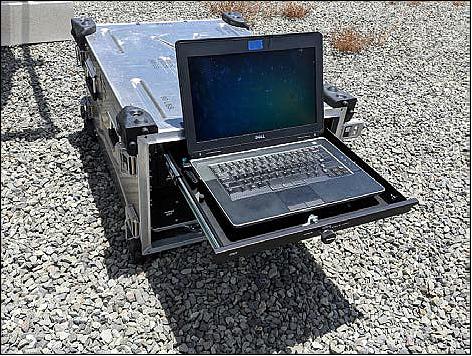
KEGS software was developed jointly between the AMA and USASMDC/ARSTRAT engineers with the former focusing on satellite interactions (i.e. commanding and telemetry) and the latter focusing primarily on the user interface software (i.e. targeting and mission planning). This government-contractor blend has resulted in greater understanding on both sides of the development as well as a natural peer review.
The high level of integration and teaming on this program has improved the risk posture of the KE JCTD (Joint Capability Technology Demo) and KEGS. The architectural design supports the KE Block II satellite and provides a good platform to demonstrate its utility in the intended applications. The lessons learned and skills developed in support of this effort are being directly transitioned into USASMDC/ARSTRAT's Ground Station efforts.
The design, fabrication, integration, and functional test of the Kestrel Eye Block II payload, spacecraft, and ground system was completed on October 20, 2016. Environmental testing of the AMA Block II spacecraft was completed in November 29, 2016.
Thanks to launch and deployment sponsorship by the Department of Defense Space Test Program, Kestrel Eye was launched August 14, 2017 as a payload aboard the SpaceX Falcon 9 rocket as part of an International Space Station CRS-12 cargo resupply mission. The Kestrel Eye Block II spacecraft was placed in a protective shell within a Crew Transfer Bag (CTB), strapped down, and launched. Once at the International Space Station (ISS), it was removed from the internal volume of the Dragon Cargo Resupply Service (CRS) Visiting Vehicle and remained in storage until the deployment opportunity.
JCTD (Joint Capability Technology Demo): After successful deployment, the On-Orbit Checkout process was started, to be followed by the technical demonstration and a military utility demonstration. The Tech Demo is a scripted series of operations intended to demonstrate the proper performance of all aspects of the Kestrel Eye satellite including bus and payload functions. A baseline for all parametric telemetry including system voltages, currents, pressures, and temperatures will be established. Communications system data rates and performance thresholds will be tested. All subsystem modes will be checked out. Attitude determination and control accuracy will be characterized. Energy balance parameters will be confirmed. Images will be captured in a variety of conditions and associated metadata will be verified. Finally, realistic tasking scenarios will be conducted to exercise all elements as well as to verify and rehearse all planned processes and procedures.
The final stage of the JCTD will be a Military Utility Demonstration. The Military Utility Demo will emulate usage of Kestrel Eye in its intended application. The designated Combatant Command will conduct this demo under realistic conditions in collaboration with representative military personnel to assess the utility of the Kestrel Eye concept. The Military Utility Demonstration will result in recommendations for an objective Kestrel Eye Satellite System.
References
1) Billy E. Johnson, Jon T. Dodson, Timothy A. Farmer, Wheeler K. Hardy, Barry W. Heflin, Melanie G. Klinner, John R. London III, Katherine E. Mott, Mason E. Nixon, Mark E. Ray, Travis S. Taylor, Barbara M. Urena, David J. Weeks, Martin F. Lindsey, "U.S. Army Small Space Update," Proceedings of the 30th Annual AIAA/USU SmallSat Conference, Logan UT, USA, August 6-11, 2016, paper: SSC16-III-06, URL: http://digitalcommons.usu.edu/cgi/viewcontent.cgi?article=3349&context=smallsat
2) Kenneth J. Bocam, Kenneth J. Hyatt, Stephen J. Kalasky, Dominick D. Risaliti, Krystal Arroyo-Flores, Fred Eckert, Gregory Gallant, Glen E. Cameron and Stephen J. Fujikawa,Wheeler K. Hardy, Mark E. Ray, Christian J. Reyes, Matthew A. Hitt, Mason E. Nixon,"Kestrel Eye Block II," Proceedings of the 32nd Annual AIAA/USU Conference on Small Satellites, Logan UT, USA, Aug. 4-9, 2018, paper: SSC18-XXX-X,URL: https://digitalcommons.usu.edu/cgi/viewcontent.cgi?article=4103&context=smallsat
3) "Kestrel Eye 2M Satellite," Spaceflight 101, 2017, URL: http://spaceflight101.com/dragon-spx12/kestrel-eye-2m/
4) "SpaceX CRS-12 Cargo Mission Launch," NASA, August 14, 2017, URL: https://www.nasa.gov/image-feature/spacex-crs-12-cargo-mission-launch
5) "CRS-12 Dragon Resupply Mission," SpaceX, URL: http://www.spacex.com/sites/spacex/files/crs12presskit.pdf
6) Lori Keesey, "NASA Set to Launch Dellingr; CubeSat Purposely Designed to Improve Reliability of Small Satellites," NASA, August 2, 2017, URL: https://www.nasa.gov/feature/goddard/2017/nasa-set-to-
launch-dellingr-cubesat-purposely-designed-to-improve-reliability-of-small-0
7) SpaceX CRS-12 Mission Overview," URL: https://www.nasa.gov/sites/default/files/atoms/
files/spacex_crs-12_missionoverview.pdf
8) "NanoRacks-SMDC-Kestrel Eye IIM (NanoRacks-KE IIM)," NASA, Aug. 16, 2017, URL: https://www.nasa.gov/mission_pages/station/research/experiments/2163.html
9) "Adcole Maryland Aerospace Announces Successful Deployment Of Kestrel Eye Block IIM," AMA, 30 Jan. 2018, URL: https://www.adcolemai.com/single-post/2018/01/30/Adcole-
Maryland-Aerospace-Announces-Successful-Deployment-Of-Kestrel-Eye-Block-IIM
10) Jason B. Cutshaw, "Army deploys Kestrel Eye satellite," SMDC/ARSTRAT, 25 Oct. 2017, URL: https://www.army.mil/article/195548/army_deploys_kestrel_eye_satellite
11) "NanoRacks Successfully Deploys First Customer Microsatellite from ISS, Largest to Date," NanoRacks, 24 Oct. 2017, URL: http://nanoracks.com/largest-customer-microsatellite-deployed/
12) "NanoRacks-SMDC-Kestrel Eye IIM (NanoRacks-KE IIM) ," NASA, released on 26 July 2018, URL: https://www.nasa.gov/mission_pages/station/research/experiments/2163.html
13) Stephen Clark, "Station crew captures Dragon supply ship, gets early start on unpacking," Spaceflight Now, August 16, 2017, URL: https://spaceflightnow.com/2017/08/16/station-crew
captures-dragon-supply-ship-gets-early-start-on-unpacking/
14) Jason Cutshaw, "Kestrel Eye demonstration comes to an end," U.S. Army, October 9, 2018, URL: https://www.army.mil/article/212211/kestrel_eye_demonstration_comes_to_an_end
Spacecraft Launch Mission Status Ground System References Back to Top